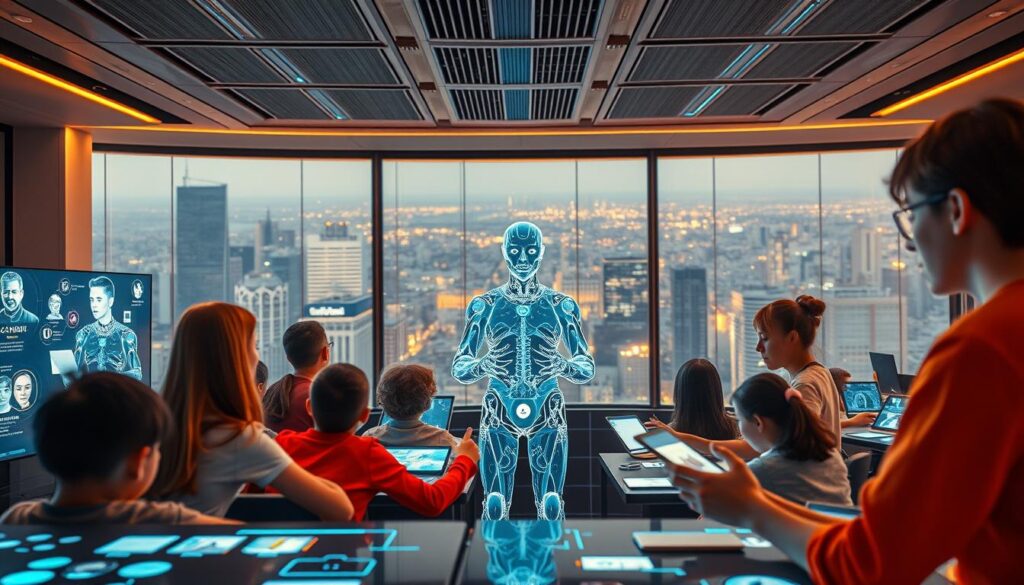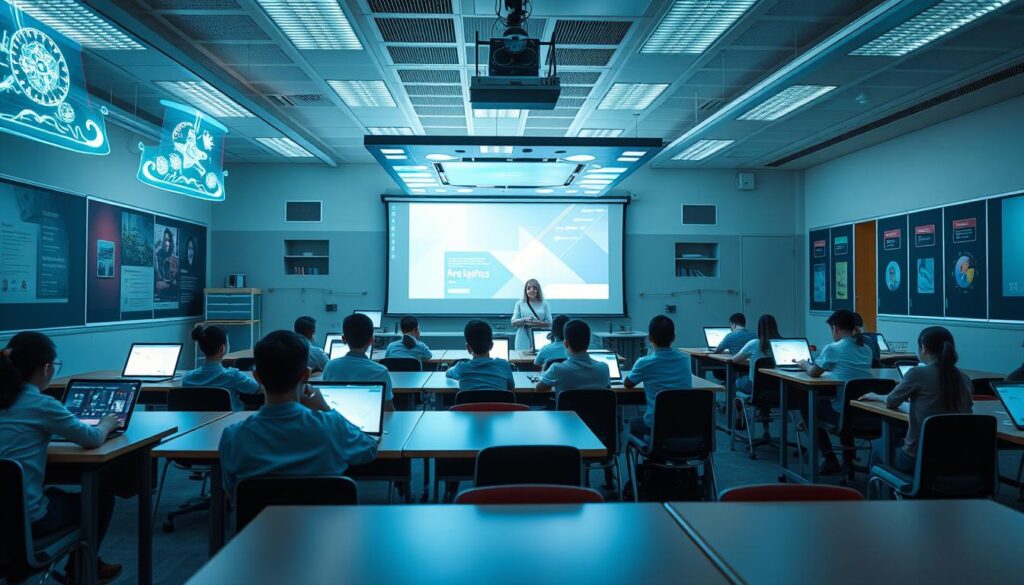
The way we learn is changing fast. Traditional classrooms are making room for smarter, tailored experiences. With artificial intelligence reshaping learning, students and educators gain tools that adapt to individual needs.
By 2025, experts predict a major shift in how knowledge is shared. The global market for AI in learning is growing rapidly, with projections showing massive adoption. Institutions leveraging these tools see better engagement and retention rates.
Greg Parry, a leader in global education, highlights how AI creates competitive advantages. Schools using these methods stand out by offering customized experiences. The future of learning is here—flexible, efficient, and accessible.
Key Takeaways
- AI-driven learning boosts engagement by 20-30%.
- The global market is set to expand significantly by 2030.
- Personalized methods help institutions stay competitive.
- Adaptive tools improve retention and performance.
- Educators can now reach students anywhere, anytime.
How AI-Powered Personalized Education is Revolutionizing Learning in 2025
Static lesson plans are being replaced by dynamic, responsive systems. These tools analyze individual needs, creating tailored pathways for each student. The result? A 62% improvement in test scores, according to recent studies.

The Shift from Traditional to Adaptive Learning
Traditional curricula often follow a one-size-fits-all approach. However, platforms like Squirrel AI use machine learning to analyze over 200 data points per student. This identifies gaps and adjusts content in real time.
Carnegie Learning’s tools take it further. They provide instant feedback, helping teachers address skill development faster. Gradescope AI reduces grading workloads by 70%, freeing educators to focus on instruction.
Key Drivers of AI Adoption in Education
Engagement is skyrocketing. AI chatbots boost interaction by 45%, making lessons more interactive. Teachers also benefit from data-driven insights, refining their methods for better outcomes.
The market reflects this shift. Projected to hit $32.27 billion by 2030, adaptive learning systems are here to stay. With 80% of K-12 educators using AI weekly, the future is already unfolding.
Benefits of AI-Powered Personalized Learning
Learning is no longer a rigid process—AI tailors it to fit every student. From boosting engagement to bridging gaps for diverse learners, these tools redefine success. Institutions report 67% higher study efficiency, proving adaptability drives results.

Improved Engagement and Retention
Static lessons fade when AI steps in. Platforms like IBM Watson analyze emotions to adjust content dynamically.
“Real-time feedback loops keep students invested,”
notes an EdTech report. Results speak volumes:
- 82% of special ed teachers see higher participation with AI tools.
- Thinkster Math’s scaffolding helps ESL learners grasp concepts 40% faster.
Enhanced Accessibility for Diverse Learners
Barriers dissolve with neuro-inclusive designs. Century Tech supports dyslexic students through visual aids, while Duolingo’s speech recognition adapts to pronunciation challenges. Accessibility isn’t optional—it’s a cornerstone of modern learning.
Empowering Educators with Data-Driven Insights
Teachers gain superpowers. McGraw-Hill Connect’s predictive analytics slash dropout risks by 30%. With 55% of schools using AI for curriculum design, educators focus on what matters: inspiring students.
Top AI Tools Transforming Education in 2025
Innovative tools are reshaping classrooms with smart solutions. From adaptive platforms to instant feedback systems, these technologies empower both students and teachers. Let’s explore the leaders driving this change.
Adaptive Learning Platforms
Squirrel AI serves over 20 million students with tailored math pathways. Its algorithms adjust content based on real-time performance. Century Tech takes it further, using cognitive mapping to build foundational skills.
These platforms analyze gaps faster than traditional methods. A student struggling with algebra gets targeted exercises, while another breezes ahead. *Efficiency meets individuality*.
Automated Grading and Feedback Systems
Turnitin’s AI achieves 73% accuracy in grading essays. Gradescope automates bubble sheets and even complex problem sets. Teachers save hours, redirecting energy to one-on-one support.
“Instant feedback loops transform how students learn,”
says an EdTech analyst. Querium’s STEM coach breaks down problems step-by-step, offering hints akin to a tutor.
AI Chatbots for 24/7 Student Support
Chatbot adoption surged 300% since 2023. Ivy Tech’s system predicts failures with 80% accuracy, alerting instructors early. Cognii’s Socratic tutor rivals ChatGPT Edu, guiding debates with nuanced responses.
These tools don’t sleep—homework help at midnight? Covered. Whether clarifying concepts or tracking progress, support is always on.
Challenges and Ethical Considerations
While AI reshapes learning, ethical dilemmas emerge. Schools and developers must navigate privacy risks, accessibility gaps, and the irreplaceable role of human mentors. Let’s examine these hurdles and solutions.

Data Privacy and Security Risks
Over 42% of teachers worry about student data leaks. Biometric details, like eye-tracking for focus analysis, require military-grade encryption. The EU’s AI Act now mandates audits for educational algorithms.
India’s DIKSHA platform shows promise with localized content but struggles with rural connectivity. Stanford’s framework recommends anonymizing datasets to protect identities while preserving insights.
| Framework | Key Requirement | Impact |
|---|---|---|
| EU AI Act | Algorithm transparency | Prevents bias in grading |
| Stanford K-12 Guide | Data anonymization | Reduces re-identification risks |
The Digital Divide and Equity Concerns
Rural students often lack devices or broadband, widening achievement gaps. 24% of learners admit using AI to complete assignments, raising plagiarism fears among 65% of educators.
Hybrid models blend tech with community hubs—libraries with offline AI tutors, for example. Grants for low-income schools can bridge hardware gaps.
Balancing AI with Human Interaction
Tools like chatbots handle queries, but mentorship thrives on empathy. A 2024 study found students prefer teachers for complex feedback. Human interaction fosters critical thinking AI can’t replicate.
“AI should assist, not replace, the teacher-student bond.”
Solutions? Train educators to interpret AI insights while preserving face-to-face connections. The future lies in synergy, not substitution.
The Future of AI in Education: Trends to Watch
The next wave of innovation in learning is already taking shape. From hyper-customized curricula to AI-generated materials, the potential for transformation is immense. Let’s explore the key trends driving this evolution.

Hyper-Personalized Curriculum Design
Learning paths are becoming as unique as fingerprints. Knewton’s fluidic modules adjust in under 50 milliseconds, responding to student inputs instantly. OpenAI’s Teachable Agent even lets students build their own AI tutors, fostering deeper engagement.
BYJU’s $1B investment in emotional AI highlights the shift toward holistic development. Tools now analyze frustration levels, adapting content to maintain motivation. The result? A 30% boost in concept retention.
Integration of Generative AI in Content Creation
By 2026, 40% of educational content could be AI-generated. Platforms like Canva Magic Write draft lesson plans, while ChatGPT Edu crafts interactive quizzes. This automation frees teachers to focus on mentorship.
“Generative AI isn’t replacing creativity—it’s amplifying it.”
VR paired with AI is another frontier. Imagine history students debating with AI-generated historical figures. The future of immersive learning is closer than we think.
Global Market Growth Projections
The Middle East’s edtech investments surged 78% last year, signaling booming growth. Southeast Asia’s market may hit $7.8B by 2027, driven by adaptive learning’s 30% CAGR.
Key drivers include:
- Demand for scalable, personalized learning.
- Government grants for AI adoption in schools.
- Rising potential of hybrid models blending tech and human touch.
Monetizing AI-Powered Education: Opportunities for Teachers
Educators now have powerful tools to turn expertise into income. AI streamlines content creation, tutoring, and partnerships, making it easier to scale impact and revenue. From custom courses to smart scheduling, the options are vast.
Creating and Selling Customized Learning Content
Udemy instructors using AI triple their course production speed. Tools like Kajabi’s outline generator automate 60% of prep work. Coursera’s $25M fund supports AI-enhanced modules, rewarding creators who blend quality with innovation.
Top strategies include:
- Repurposing lesson plans into micro-courses (e.g., Chegg’s $100K+ earners).
- Using AI to localize content for global audiences.
Leveraging AI for Online Tutoring and Coaching
VIPKid’s matching system boosts tutor bookings by 40%. Preply’s smart scheduling saves 7 hours weekly, while Khan Academy’s marketplace connects teachers with learners worldwide. Real-time feedback tools, like chatbots, enhance engagement.
| Platform | Feature | Earnings Potential |
|---|---|---|
| Outschool | AI-enhanced classes | 120% YOY growth |
| Preply | Automated scheduling | $50+/hour |
Partnering with EdTech Platforms
Collaborations with platforms like Coursera or Duolingo offer passive income. Teachers contribute expertise while AI handles scaling. For example, language coaches earn royalties from adaptive exercises.
“AI handles logistics; educators focus on inspiration.”
Key steps to start:
- Audit existing resources for repurposing.
- Join training programs for AI tool mastery.
Conclusion: Embracing the AI-Driven Educational Revolution
The classroom of tomorrow blends human expertise with AI precision. With 99.4% of institutions calling AI critical for competitiveness, the shift is undeniable. Revolutionizing education means adopting tools that enhance, not replace, mentorship.
UNESCO’s competency framework offers a blueprint for ethical integration. By 2026, AI literacy certifications may become mandatory, ensuring equitable growth. Public-private partnerships can bridge gaps, making tech accessible to all.
This future thrives on collaboration. AI handles data; teachers inspire minds. Together, they drive development that’s inclusive and impactful. The time to act is now—educators leading the charge in revolutionizing education.
